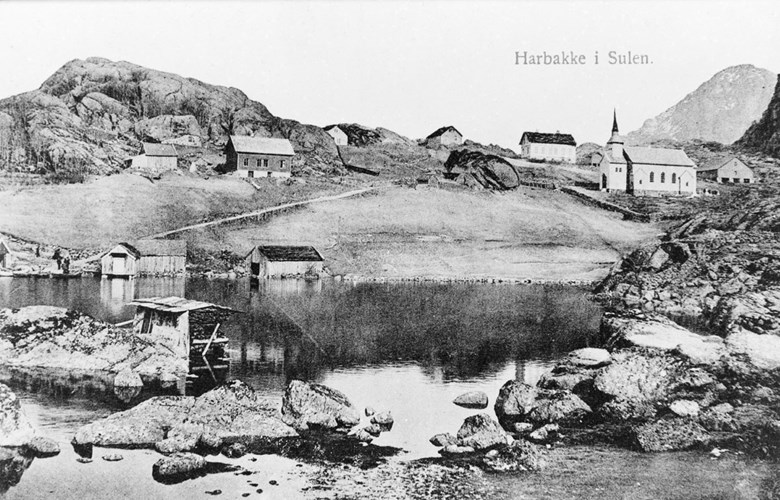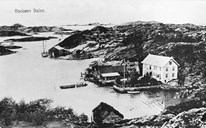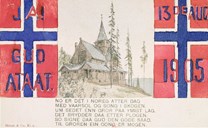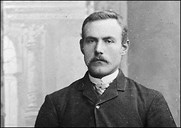The municipality of Solund in 1905
Solund municipality was in 1905, as it is today, a purely island kingdom. The island of Losna, now a part of Solund, belonged to the municipality of Gulen. In 1923, the name of the municipality had been changed to Solund, yet the change of name was an old issue. In 1903 and in 1905, the municipal council sought the approval of the national cabinet to take the name of Solundir. The municipality comprised the parishes of Husøy, Solund, and Hersvik, and was a "thing" (court division) under the bailiff of Sogn.
In 1900, the population of the municipality was 1920. The most important industry was the combination of fisheries and agriculture. The trade with fresh fish, crab, and lobster was also growing at this time. Important were as well various subsidiary industries of the fisheries, such as salting, barrel production, the production of fishing nets, maintenance of nets, etc.. The most important trading posts were at Kolgrov, Steinsundholmen, Inderøy, and Buskøy. There were still no banks or telephone exchange. In 1900, there were five post offices, at Solund, Tangenes, Nåra, Buskøy, and Krakhella.
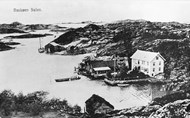
There was only one navigable road in the municipality, from Solund church to the farm Hop. The sea was the main communication artery, and rowboats and open sailing-boats were still used. The motor vessel was not yet common property. Without roads and encircled by water, Fylkesbaatane (steamship company) was more important to the people of Solund than to most other people. In 1904, there were seven boat stops, at Buskøy, Krakhella, Lågøy, Nesefjord, Nåra, Steinsund, and Tangenes. In terms of population Solund had more boat stops than any other municipality in the county.
The municipality was divided into fourteen school districts, with 318 children of compulsory school age, and six teachers. Solund shared a district physician with Gulen, the office being located at Eivindvik. The municipality had its own midwives.
Other issues and events besides the dissolution of the union
The dissolution of the union was the all-important issue throughout all of 1905, yet there were other issues also which interested people. The language issue - the work to use "nynorsk" more - preoccupied a good many, as was the case with the emigration to America. Another important matter was the health service.
The protocol of the municipal council gives a picture of the daily life in Solund. The introduction of hymns in "nynorsk" (Blix hymns) in the churches was an issue at the time, also in Solund. The municipal council asked the vicar to promote in all the congregations "some hymns" by Elias Blix. But the time was not ripe, only in 1915 was Blix introduced in the churches.
Examples of other public issues were the dredging and deepening of the sea lane of Indre Steinsund, more lighthouses, a stove and new seats in Solund church, appointment of midwife in Husøy district, application to protect the property Gåsvær as nesting place to collect eggs and eiderdown, renovation of the schoolhouse at Hardbakke, application for exemption from the Salmon Act, and application to the telephone board to build a telephone line to Solund. Only in 1910 was the first telephone line built in Solund.
Some important individuals
There were local elections in 1904, and the fisherman and farmer Johannes Kristofferson Laagø became mayor. Rasmus Haugsøen was vicar. He came from Gulen, a great orator, advocate of "nynorsk", public educator, and an enthusiastic follower of Grundtvig. Haugsøen was regarded as a pioneer in the struggle for the use of "nynorsk" in the churches of western Norway. He gave all his sermons in "nynorsk", but the struggle was hard in Solund. The island people wanted "bokmål" for Sundays, and in the church at Straumen there was even a minor demonstration during a service. Johannes Mathiesen was bailiff until 1906, but his son Magnus O. Mathiesen was approved as deputy and held the office of bailiff in 1905.

Few clubs and associations
There seem to have been few clubs and associations in Solund around 1905. The building of organizations seems to have started a decade later. There is no sign of the women missionary associations which existed traditionally in every community. But the voluntary rifle movement was strong all over the country, and Solund was no exception. There were for example Hardbakke skyttarlag (rifle association), founded in 1896, and Domben og Austefjord Skyttarlag was founded in 1900. The latter was affiliated to Bergen Skyttarsamlag.
The liberal youth movement had reached Solund, and on 26 July, 1896 the first youth association, Vårvon, was founded. The source of inspiration was here, as in so many places in the county, Sogndal Folkehøgskule. When they were on their way to a meeting, they used the fishing vessel Solundir, and with the vicar Haugsøen on board, there was always singing and a cheerful atmosphere.
Around 1900, there was large-scale forestation work in Norway, and it was seen as particularly important to plant forest along the barren coast. In Solund many farmers entered agreements with Bergen Skogselskap to plant spruce. The work was to a great extent done by clubs and association, and the liberal youth associations in the district planted a lot of forest. The youth association at Gylta could have been one of them.
17 May, 1905
The 17 May celebrations in 1905 drew larger crowds than usual. In many places 17 May church services were held with large attendance. In Solund there was a service in Hersvik church, where the theme was: "Prayer and labour open the doors to the happiness of our people". In the afternoon the vicar gave a speech for the youth association at Gylta. Haugsøen was an articulate and very popular orator in the youth associations. Where Haugsøen spoke, the house was always full. With the prevailing atmosphere on 17 May of this year, he probably gave encouragement to the people of Solund.
7 June, 1905 and announcement in the churches on Whitsunday
7 June, 1905, the day on which the union with Sweden was dissolved, was a Wednesday and an ordinary working day, yet the people waited in excited anticipation for the latest news from the capital and from the Storting. As the news came out, people hoisted their flags, and in some places they sent telegrams of greetings to the authorities. The Storting released an announcement about the dissolution of the union. The church ministry asked the vicars to read the announcement in the churches on Whitsunday, 11 June, or later. The vicar of Solund has not registered that he read the announcement on Whitsunday, but this could be because the announcement had not reached him, or it could have been an oversight.
The referendums - the suffrage and election committee
There were two referendums in 1905:
1) On Sunday 13 August, when the people were asked to say yes or no to the dissolution of the union which had taken place on 7 June.
2) On Sunday 12 and Monday 13 November, when the people were asked to advise the Storting on the coronation of a king. In reality this was a choice between monarchy or republic.

The election district comprised Solund parish, which corresponded to the then Sulen municipality. The election committee consisted of: deputy bailiff M. O. Mathiesen (chairman), Bernt P. Kalgraf (in August), Bernt Kværhellen (in November), Elias Stensund, Paul Takle, and J. Kr. Laagø.
The election committee decided where the votes should be cast, and who should vote where. The referendum on 13 August took place in the parish church of Solund at Hardbakke.
Even during the early autumn, the weather could be rough in an open small boat to get to Hardbakke. Jan Hess, enterprising owner of fishing-vessels, seal hunter, and exporter of fish from Buskøy, owned an 81-foot steamboat named "Solundir", which he used to transport voters to the polling station at Hardbakke, because he felt uneasy that they would not get there.
At the referendum on 12 and 13 November there were two polling stations. Votes were cast at the Solund main church at Hardbakke, by voters from Hersvik and Solund sub-parishes, and at Husøy church at Straumen, by voters from Husøy sub-parish. The chairman of the election committee, the bailiff M.O. Mathiesen, supervised the voting for Solund and Hersvik, while Bernt Kværhellen was chairman of the special election committee for Husøy sub-parish. After the close of the polling stations, the chairman for Husøy sub-parish transferred the votes to the chairman of the election committee. The counting of the votes took place this time also at the church at Hardbakke.
The referendum in August - yes or no to the dissolution of the union
The result in the constituency:
405 men had the right to vote. The count showed 326 valid votes, while one vote was rejected. The turnout was thus 80.7%. All voted yes. In the county of Sogn og Fjordane the turnout was 92.5%, and only three voted no.
Private petition by women
Women did not have the suffrage in 1905. But the women wanted to say their yes along with the men. Several women's organizations joined forces in a countrywide petition, and on 22 August they handed over more than 250,000 signatures to the Storting.
The collection of signatures was organized in different ways. Announcements in newspapers encouraged women to sign their names on the lists. At Leikanger this took place at the church, where the women could write their names on lists in the vestry on the day of the referendum. In other places lists were placed in shops and wherever people travelled. In Solund no information on this initiative has been found, yet such lists have probably been in circulation also in Solund.
The referendum in November - monarchy or republic
The result of the referendum in November for the Solund constituency: Of 408 men with the right to vote, 324 voted. All votes cast were valid. 311 voted yes (for monarchy), while 13 voted no (for republic). The turnout was roughly the same as at the August referendum, which is perhaps surprising because the average for the county as a whole and the nation was lower in November. The support of the monarchy varied in the county, but the people of Solund were royalists. Together with the neighbouring municipality of Hyllestad the vote for monarchy in Solund was the highest in the county with 96%. The average for the county as a whole was 80.4%, and the average turnout was 79%.
The new royal family
On 18 November the Storting chose Prince Carl of Denmark King of Norway. He was married to Princess Maud of England, and their son's name was Alexander. Prince Carl took the name Haakon VII, and Alexander's name was changed to Olav. The new royal family arrived in Kristiania (Oslo) on the Norwegian navy vessel "Heimdal" in the evening of 25 November, and thousands of enthusiastic people had come to receive them.
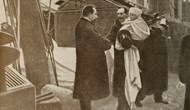
Welcome telegrams arrived in great numbers from all over the country, and the municipal council of Solund on 6 December decided under item 21 the following: "Unanimously decided to send telegram of tribute to the Storting, the cabinet, and to the royal family."
Celebrations and thanksgiving service with lit candles
In many places in the country celebrations were organized in December to mark the eventful year 1905. But the year was also observed in the churches. In Straumen church there was a service on 26 November, the day after the new royal family had arrived in the country. In the register the vicar has written from the sermon: "Theme: Render unto Caesar the things which are Caesar¿s; and unto God the things that are God¿s. - Thereafter referred to the events of the summer and the new day for Norway: admonished to thank God and to obedience to the laws of the land. - The national hymn was sung at the close. People asked to have the candles lit."
In accordance with the request from the central authorities thanksgiving services were held all over the country on 7 December. In Solund it took place at the Hardbakke church. The church prayer was on this day replaced by a prayer of thanks written for the occasion. The church ministry had also asked that the national hymn "Gud signe vaart dyre fædreland (May God bless our precious nation)" by Blix be sung.

